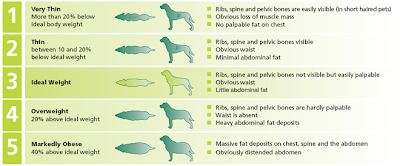Pet Obesity: Cut The Fat!
Let me start with a simple, bullet-proof argument for why you should care about your pet’s weight. Nestle-Purina studied 48 Labradors over the course of their entire lives. They were split into two groups, with only one difference – one group was allowed to over-eat and grow fat, while the others were kept at an ideal body weight.
On average, the overweight dogs died almost two years earlier. They also developed more health problems, and at earlier ages.
A recent study found that over 50% of dogs and cats are overweight. That means if you have two pets, the odds are one needs to trim down, whether you realize it or not. And you likely don’trealize it, because our society has normalized pet obesity to the point where many think an ideal weight looks “skinny,” overweight animals are “just right,” and obese pets are…cute. Well, fat pets may be cute for all I know, but as a veterinarian I can promise you this – they aren’t healthy. Their lives will be shorter, and they will have more health problems.
So, what does a healthy weight look like? Dogs and cats come in every shape and size, so we can’t just look at animal and say it should be <x> weight. Instead, veterinarians use body condition scoring to evaluate pets, looking at many specifics to come up with a numerical score. However, you can easily use three quick checks at home to get an idea of where your pet sits. An ideal weight pet should:
- Have a waist when viewed from above
- Have a waist when viewed from the side
- Have ribs that are easily palpable – you shouldn’t see them (that’s too skinny), but there should be little if any fat over them.

Put your hands on the pet and feel for a waist – especially with long-haired furballs, since all that fluff can make even skinny dogs look hefty. If your pet passes all those tests, you’re in good shape (and so are they). But if they look and feel like a straight-case sausage from ribs to rump, or they’re bulging at the seams – it’s diet time. If they’re just a little overweight, that’s okay, right? Wrong. They’re still overweight, and they’ll still have real health benefits from trimming down.
Cutting the Fat
First off, if you’re trying to take a large amount of weight off your pet I strongly advise you to put together a plan with your veterinarian and their staff. You can run into some significant nutritional concerns when cutting calories way back, not to mention a little support and guidance goes a long way toward reaching those goals. They can help you estimate how many calories your pet needs, and help you figure out an appropriate food – especially important since virtually no pet food companies make calorie counts available. Worse yet, terms like “weight management” are not regulated – there are “weight management” foods out there with as many calories as puppy food. That said, the general principle of weight loss boils down to a simple concept: calories used need to be greater than calories taken in. And, with that in mind, here are five general tips to help your pet slim down and live a longer, healthier life.
- Stop treats and table scraps: Treats are the single biggest factor in obesity. An ounce of cheese typically has over 100 calories – for toy breeds this may be 1/3 of their daily calorie needs! Limit treats to no more than one a day – it’s supposed to be special, after all – and replace fatty store-bought stuff with raw veggies. Most dogs love carrots and green beans.
- Replace treats: Attention, touch and play are just as rewarding to pets as food; when you have the urge to give them a treat, grab a toy or laser pointer instead and give them some exercise!
- Change to “Light” food: The term “light” is one of the few regulated words on pet food packages; it guarantees the calories per cup are less than most foods. Note that other terms like “weight management” are not regulated and may have just as many calories (or more) than normal adult diets.
- Switch to multiple small meals: No animal (me included) will lose weight while living at a buffet. You need to offer a set amount of food per day – this is best settled on with your veterinary staff, but you can try estimating what weight they should be and feeding the bottom end of what the bag recommends for that weight. Feeding several small meals is beneficial on two counts – it reduces hunger throughout the day, and digesting each meal burns a little extra energy .
- Make an exercise plan: Set goals for walking or playing – be specific on how often and for how long. A great way to exercise your cat is to make an event out of one meal a day – take the allotted kibble and throw it across the room, one piece at a time. I’ve yet to meet the fat cat that won’t run for dinner.
For mild to moderate weight loss you can likely succeed just by following the simple guidelines above. For heavier pets or stubborn pounds, your veterinarian can help with special diets and more specific advice. But the most important job is yours – deciding your pet needs to lose weight, needs to live a longer, healthier life, and deciding that you need to make it happen.
